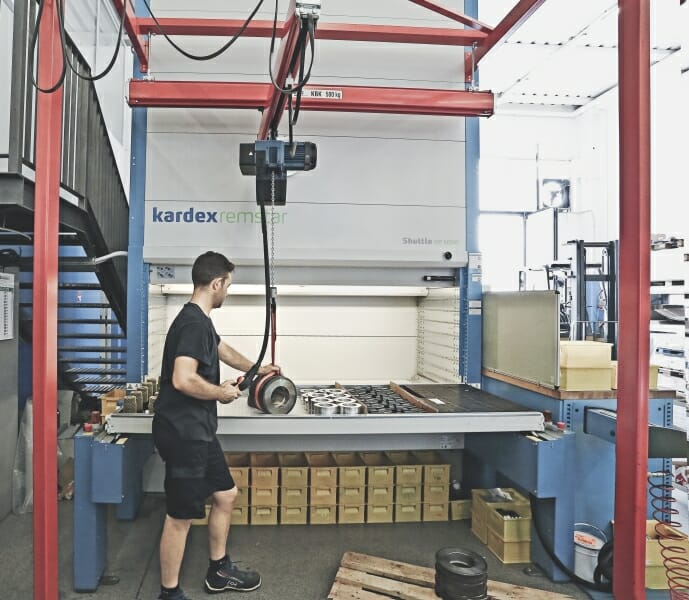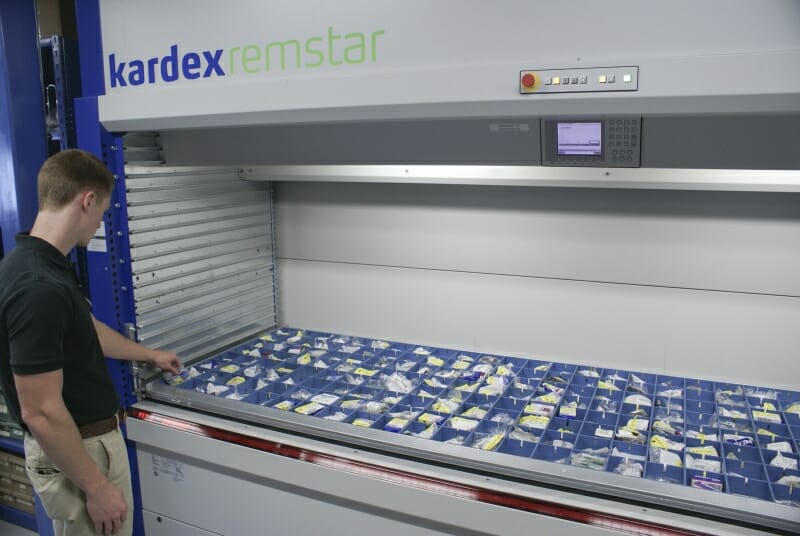Material handling in a typical machining or manufacturing operation can account for a large percentage of production time. With a focus on leaner efficiency it’s worth looking at more efficient storing, handling and retrieval of your materials.
Automated storage and retrieval systems are a smart alternative to traditional shelving and rack systems. Vertical carousels and Lift systems solve many of the problems associated with poor utilisation of floor space, throughput restrictions, centralised stockrooms, information and inventory management, lean manufacturing and quick response/JIT disciplines. In the process, they can significantly reduce operating costs.
Vertical storage and retrieval systems consist of two primary devices. One is called a vertical carousel that uses rotating carriers, or shelves, that move on a track (like a Ferris wheel) in response to operator commands. The other vertical device is a VLM (Vertical Lift Module). VLMs consist of a series of trays that are mounted on both sides of an inserter/extractor device. With both the vertical carousel and VLM, items are automatically delivered to the operator at an ergonomically positioned work counter, eliminating walking, searching, bending and stooping.
These systems come in a wide range of capacities and configurations and can be used for a number of storage and retrieval requirements. There are vertical systems that can easily handle tools, dies and pallets with each carrier able to accommodate up to 11,025 pounds. Some of these units are available with up to 210 shelf levels for a total unit capacity of 2,315,250 pounds. Other vertical storage and retrieval systems are designed specifically to store small tooling and consumable safety items. “Standard” vertical storage and retrieval systems can hold items as large as heavy tooling and sub-assemblies and as small as screws and other fasteners.
When looking at increasing productivity and leaner manufacturing options you need to consider the following:
- Nature of the load to be stored
- System throughput
- Defining control requirements
Conventional static storage systems like shelving require employees to spend up to 70 percent of their time searching for items. On average, in typical industrial applications, productivity throughput can increase by more than 2.5 times.

One of the primary reasons for considering a vertical system is the improved space utilisation they offer. Depending on useable building interior heights, a significant percentage of a conventional storage system’s occupied floor space can be recovered. The small unit footprint makes vertical systems especially valuable for point-of-use storage and JIT manufacturing applications. Recovered floor space can be re-allocated from cost-associated functions of inventory to value-increasing production operations. Improved space utilisation can also extend the useful life of existing facilities, eliminating the need for expensive brick and mortar expansion to meet growth requirements.
Redundant or non-essential handling can be reduced with vertical systems, especially in applications frequent reuse of tools and dies. The time saved results in less operating costs and improved customer service. Labour costs are reduced due to the system’s quick retrieval times and the capability to meet varying throughput requirements while not being bound by thresholds imposed by limited-access systems. Typically, an operator’s walk and search time is reversed from that of conventional systems to 70 percent picking and only 30 percent dwell time.
There are a number of important factors to consider when planning the installation of a vertical storage and retrieval system. A properly applied approach to planning and specifying can substantially enhance the benefits these systems offer. To learn more contact Kardex Remstar at [email protected]






